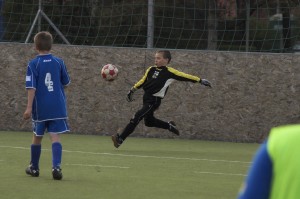Let’s assume that you have fullbacks that are competent defenders and you want them to add an attacking dimension to their game. The secret to do this is through ball control. 
As attacking fullbacks, your players need control in three phases of their game. These include receiving the ball, carrying it forward, and placing an accurate cross into the goal mouth. They’ll also need to be able to beat opponents and this skill will come with confidence when the three main phases are mastered. Players from pee wee age up to under-16s can benefit from learning how to attach from the fullback positions.
1) Receiving the ball – is a facet of the game that must be mastered no matter what position your players play. As a fullback an attacking run may be started from a successful tackle or it could be launched because of an opponent’s error. The most likely scenario is when the fullback runs up the touchline into space and then receives the ball from a teammate. Have your players team up in pairs in practice and have the fullback run down the line and receive a pass in stride. If the player is a right back, then the ball will be coming from the left.
2) Carrying the ball forward – When moving forward it’s best to remember the following principles.
• Players should keep the ball within a comfortable playing distance
• Players should stay evenly balanced so they can move easily off either foot if challenged
• Players should try not to concentrate all their attention on the ball. In fact, the less they can look at it and still maintain possession the better. If they’re always staring down at the ball then they can’t see what their teammates are doing!
Have players practice by dribbling a ball on their own in a confined space, such as the penalty area. They should do this until they get the feel of the ball. Then have them repeat the exercise using only one foot – left foot only, then right foot only. Eventually introduce teammates into this area, all with their own ball. Now with all of the chaos it’s easy to see why a player should look up and notice what’s going on around the field. If they don’t, they’ll either collide with another player or lose control of their ball.
3) Getting in the cross – It’s enough to get the cross high into the penalty area and then it is the forward’s responsibility to be there to meet it. Here’s a routine to try that also serves as a great transition drill –
Have the right-back on your team line-up on the half-way line by the right touchline. This is the sort of position he might find himself in during a game. Have the left-back to do the same on his side of the field, and put your goal¬keeper in the goal that the backs are facing. Line up the rest of the team in the center-circle facing the goal, each with a ball. Team-mate one moves off towards the goal with his ball. After he has gone ten yards or so he passes it out to the right for the right back to move onto. He must then carry the ball under close control, and as fast as he can without losing control, almost to the goal-line. Then he is to stop, look up, and cross the ball into the penalty area, aiming for the team-mate who has run into the box. He must try to head the crossed ball into goal.
This cross must be launched into areas where the forwards will be looking to meet it. If the fullback makes a break from defense on his own, he must be prepared to hold on to the ball until he spots a team-mate–even if it means taking on more defenders. This will require confidence – and confidence only comes from practice. But, remember to never forget that as a full-back the primary task is to defend and only attack when sure there is cover from behind!


No comments yet.